Command Palette
Search for a command to run...
Interdisciplinary Innovation Far Surpasses Human Capabilities? AI Scientists Propose hypotheses/conduct experiments/present at Top Conferences, Ushering in a New Paradigm for Scientific research.
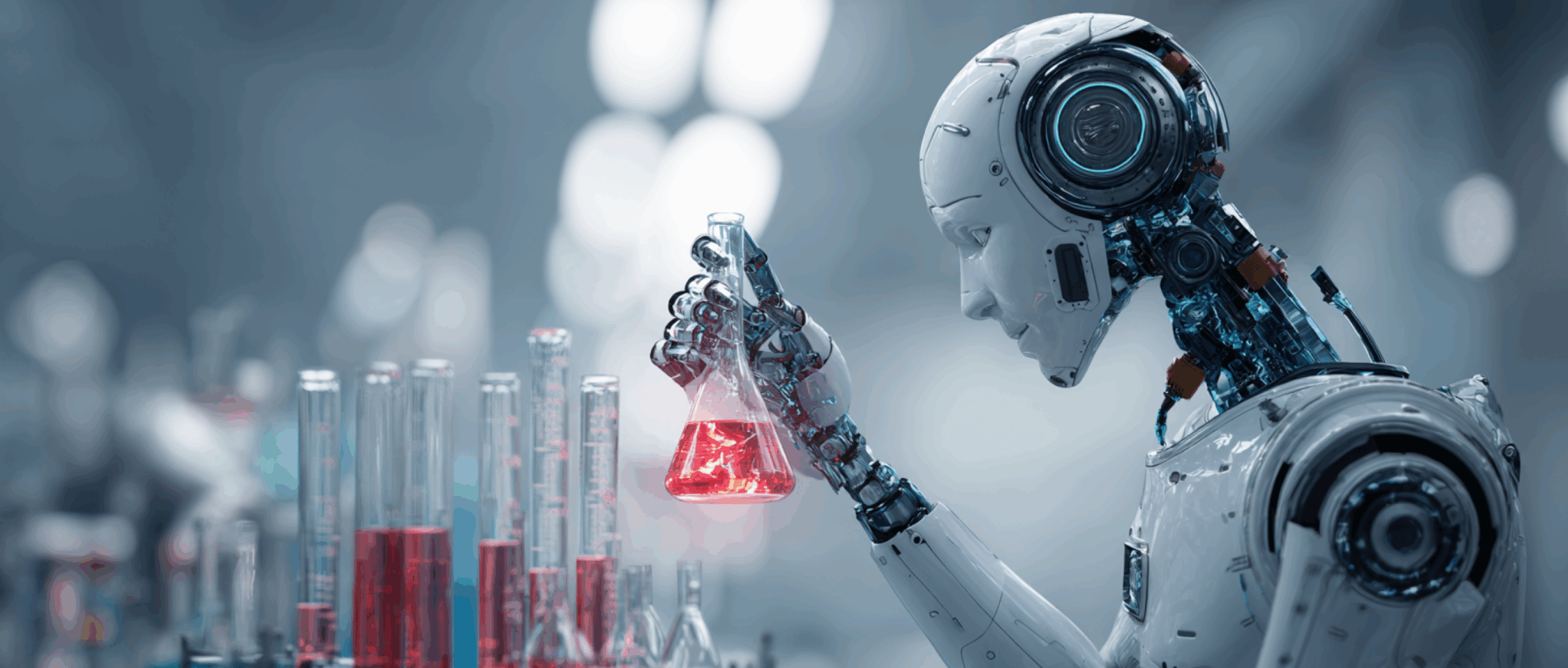
In August 2024, Sakana AI, a company founded by Llion Jones, one of the authors of the Transformer paper, was established.They announced the launch of the world's first "AI Scientist".By autonomously generating research ideas, designing experiments, writing code, executing experiments, and even writing papers, and with the help of "AI reviewers" to evaluate and improve the results, a complete closed-loop scientific research ecosystem has been formed. In March of this year, the system produced a computer science paper...Passed the double-blind review at the ICLR 2025 workshop.At the same time, the Autoscience Institute also announced that a paper written by its AI system Carl was accepted by ICLR's Tiny Papers track.
In some ways, these AI scientists have stepped out of the laboratory and are gradually climbing to a level comparable to human researchers.
However, when AI sets its sights on scientific discoveries, the outcome may be bittersweet for humanity.on the one hand,AI’s advantages in data processing and information integration efficiency are undoubtedly the key to its entry into the scientific research community, which can liberate human scientists to carry out more high-dimensional thinking and exploration.on the other hand,Its black box dilemma is difficult to resolve, and there is an unbridgeable gap in scientific research, a field that has strict requirements for interpretability.
So, how exactly do we define AI scientists? What are their future prospects and concerns?
AI Scientist: A Redefined Role
In traditional understanding, scientists are the absolute core of scientific exploration: they extract questions from observed phenomena, propose hypotheses based on existing theories, design rigorous experimental plans, personally operate equipment to acquire data, and finally draw conclusions through analysis and reasoning. This process has continued for hundreds of years, shaping humanity's basic understanding of scientific research.
But the explosion of AI technology is deconstructing this traditional role.
In today's scientific research landscape, scientists' roles are becoming increasingly distinct: large language models and specialized algorithms are responsible for extrapolating massive possibilities and screening candidate solutions from hundreds of millions of molecular structures; automated robots and experimental platforms precisely execute repetitive operations such as synthesis, observation, and detection, working 24/7; while human scientists focus on the more core value aspect—interpreting the results generated by AI, judging their scientific significance, and proposing new directions for exploration.
DeepMind CEO Demis Hassabis believes that "AI scientists will become modern versions of microscopes and telescopes, helping us discover patterns that humans cannot see." This means that AI has transcended its purely instrumental role, evolving from an "accelerator" of the research process to a "community member" of scientific reasoning and exploration.
MIT Professor Regina Barzilay further elaborated on this relationship in her TED talk:"The future of science will not be about AI replacing scientists, but rather scientists choosing to work with AI." In her view, the relationship between AI and human scientists is by no means a zero-sum game, but rather a collaborative creation based on their respective strengths—just as the invention of the microscope did not replace biologists, but rather ushered in a new era of biological research at the cellular level.
2025 Nobel Prize in Chemistry laureate, Omar Mwannes Yaghi, the "father of MOF," also has confidence in AI scientists.He stated frankly, "AI is not just about helping scientists, but about giving science itself a new way of thinking."
Real-world classifications and progress of AI scientists
Indeed, the significance of AI scientists goes far beyond making scientific research "faster"; they are gradually becoming a key player in the scientific innovation system.
Currently, numerous research institutions and technology companies worldwide are racing to explore AI scientist systems with unique features. Based on their functional positioning, these systems can be broadly categorized into two approaches: enhanced research assistants and autonomous scientific discoverers.
The core goal of the first type of system is to make AI a "second brain" for human scientists.In other words, under the premise that humans lead the research direction, intelligent agents are responsible for providing support such as interdisciplinary knowledge integration, experimental idea generation, and data analysis.
Stanford University's Virtual Lab, an online system, exemplifies this approach. This system automatically assembles AI scientist teams with diverse disciplinary backgrounds to collaboratively solve complex problems based on researchers' needs. Virtual Lab's virtual collaborative teams include roles such as "immunologists" and "computational biologists," and they have proposed a novel computational design framework for nanobody nanobodies, successfully assisting human scientists in designing 92 antiviral nanobodies.
The emergence of such systems is reshaping the boundaries of scientific research collaboration—scientific research is no longer just a collaboration between people, but can also be a deep co-creation between people and intelligent agents.
Paper link:
https://www.nature.com/articles/s41586-025-09442-9
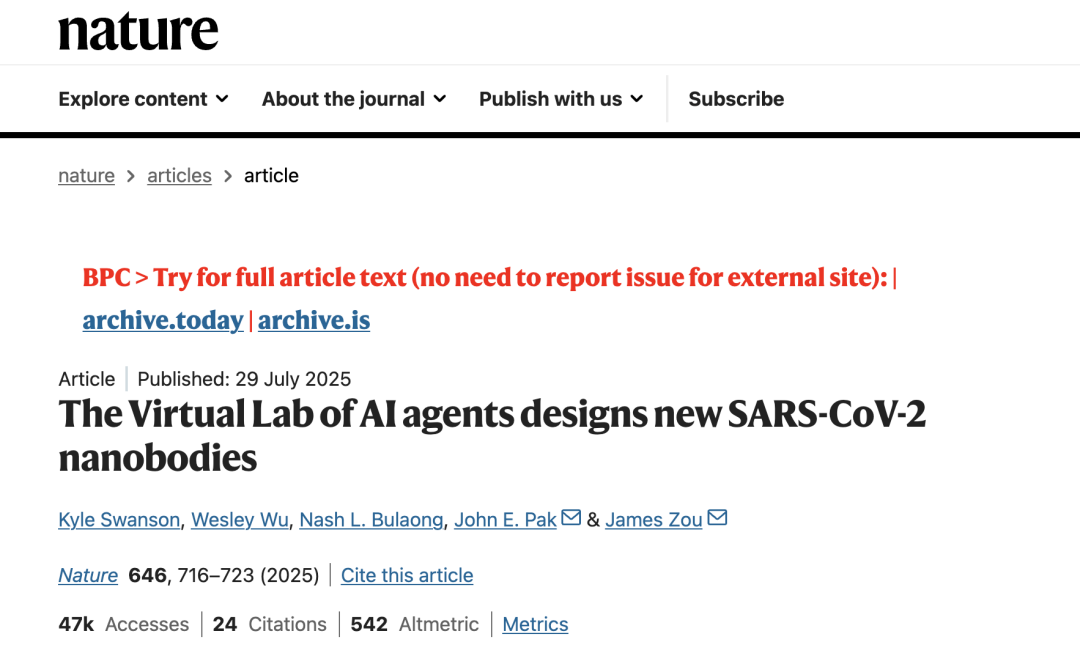
The second type of system is more ambitious, aiming to build a fully autonomous engine for scientific discovery.
These AI scientists no longer rely on human guidance, but rather on multiple intelligent agents collaborating to complete the entire research loop, from problem formulation and hypothesis generation to experimental verification and paper writing. The role of human scientists shifts more towards setting macro-level research goals, verifying results, and providing ethical review.
For example,In May 2025, the US AI research institution Future House announced that its multi-agent system Robin had autonomously discovered a candidate drug for treating dry macular degeneration (one of the leading causes of blindness).The mechanism of action was verified through RNA experiments. All hypotheses, experimental protocols, data analysis, and data charts in the published paper were completed by Robin, making it the first AI system to autonomously discover and validate novel drug candidates within an iterative laboratory cycle framework.
This means that AI scientists can not only raise research questions, but also make clinically promising discoveries in the extremely complex field of life sciences.
Company website:https://www.futurehouse.org/
Overall, whether it's the "assisted" type aimed at improving research efficiency or the "autonomous" type pursuing autonomous reasoning and experimental design, AI scientists are moving from concept to implementation.
It is precisely these rapid advancements in reality that allow us to observe more clearly what advantages AI brings that surpass those of humans when it truly participates in scientific research.
Advantages: Breakthrough speed, expanded scale, cross-industry innovation
Speed advantage: From "years of research" to "hours of verification"
For a long time, the cost of time and the lengthy research and development cycle have plagued scientists. Even with continuous equipment upgrades, it has been difficult to achieve exponential leaps in speed. In materials science, the screening and validation of a new functional compound often takes several years; in drug development, the preclinical optimization phase of candidate molecules alone can take 3-5 years. This lengthy cycle severely restricts the pace of scientific progress.
The emergence of AI scientists has completely broken this time constraint.Through a closed-loop system of "model prediction – experimental verification – data feedback – iterative optimization", the research cycle is compressed to a fraction of its original length, or even a fraction of its original length.Sakana AI's system can complete the entire process from literature review to paper drafting in a few hours, while Google DeepMind's "AI Co-Scientist" has set a record of solving a problem that has taken humans years to solve in just two days. The puzzle of DNA transmission across species, which Professor José Penadés' team at Imperial College London has been studying for years, was precisely solved by the system. Its core hypothesis is completely consistent with the team's unpublished findings, and even the accompanying alternative hypotheses have shown to be correct after preliminary verification.
Company website:https://deepmind.google/
A more representative example is the performance of AI scientist Kosmos: in a single run, it can automatically read 1,500 academic papers and execute 42,000 lines of code, generating 9.8 times more code than similar systems.It only takes one day to complete the equivalent of six months of research work for human scientists.
Company website:https://edisonscientific.com/
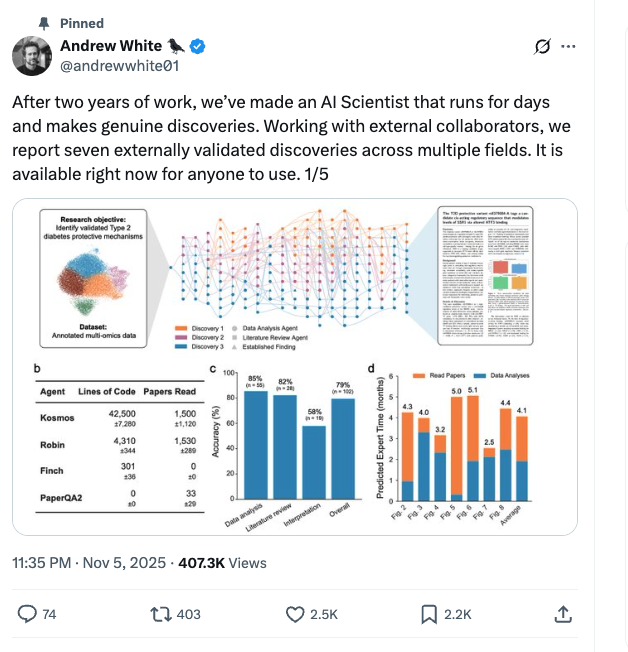
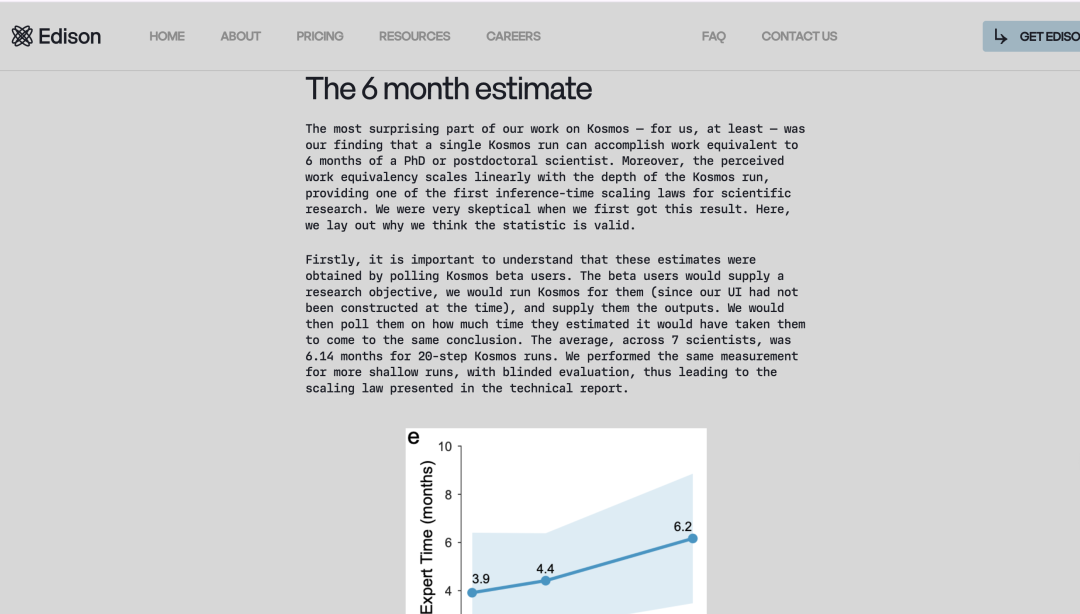
Scale advantage: handling hundreds of millions of tasks simultaneously
The second core advantage of AI scientists lies in their ability to explore at scale.
The limitations of human cognition dictate that traditional scientific research can only focus on a limited number of research directions, while AI scientists possess the ability of "panoramic search," capable of handling hundreds of millions of parallel tasks simultaneously, expanding the scope of scientific exploration to a scale that is inaccessible to humans.
For example, in the field of drug development, AI can directly generate and test thousands of candidate molecules, screen out the most promising structures, and then hand them over to robotic experimental platforms for verification. The emergence of this type of "parallel scientific experiment" has freed science from the physical boundaries of the laboratory and allowed it to enter a computation-driven "virtual experimental universe."
In the field of molecular biology,AI Co-Scientist can simultaneously simulate the interactions of hundreds of thousands of proteins and small molecules, thereby screening out potential drug targets. The "From Molecules to Society" platform developed by Professor Yaghi's team can generate tens of thousands of MOF molecular structures at once in its design layer. By screening out the most valuable candidates through multi-dimensional parameters, this scale is hundreds of times the amount of work a human team can do in a year.
In energy materials research,The SciAgents system connects 230 million scientific concepts using an ontology knowledge graph.It can simultaneously simulate the performance of different materials under ever-changing temperature and pressure conditions, a scale that far exceeds the capabilities of any human research team.

Paper address:
https://arxiv.org/abs/2409.05556
Interdisciplinary breakthroughs: Breaking down the "dimensional barriers" in scientific research
Traditional scientific research is characterized by strict disciplinary barriers.Biologists struggle to fully grasp the theoretical framework of quantum chemistry.Materials engineers often lack expertise in gene editing. This disciplinary separation causes many opportunities for innovation in interdisciplinary fields to be missed—which is precisely where AI scientists have a natural advantage.
AI scientists are not bound by the boundaries of human knowledge and can freely move between different disciplines to achieve interdisciplinary knowledge integration and innovation. The Coscientist system developed by CMU is a typical example: when it receives a natural language command to "synthesize a new conductive polymer", it can autonomously search chemical synthesis literature, materials science databases and electronic engineering standards, integrate multidisciplinary methods such as chemical synthesis route design, conductivity prediction and stability testing, and finally complete the experiment through a robotic platform. The whole process does not require the adjustment costs of human interdisciplinary collaboration.
Professor Yaghi's seven AI agent collaborative experiments further demonstrated the depth of interdisciplinary collaboration: the experiment planner was responsible for the overall scheme design, the literature analyst focused on materials science literature, the algorithm coder developed the Bayesian optimization program, the robot controller connected to the experimental equipment, and the safety consultant carried out risk management in accordance with chemical safety standards.These AI agents, belonging to different disciplines, worked together to successfully solve the long-standing problem of the COF-323 material's inability to crystallize.This represents a breakthrough in achieving amorphous to highly crystalline forms.
Paper link:
https://pubs.acs.org/doi/10.1021/acscentsci.3c01087
This advantage is even more pronounced in interdisciplinary fields. Research from Stanford University shows that AI scientists' research hypotheses...Of these, 37% belong to interdisciplinary innovation, while such hypotheses account for less than 5% in proposals from human scientists.
While AI scientists have demonstrated unprecedented advantages in speed, scale, and interdisciplinary capabilities, this rapid development has also brought new problems and risks, and challenges have followed.
Challenges: The Black Box of AI Scientists, Ethics, and Cognitive Boundaries
The black box dilemma: "Causal imbalance" where only answers are given without explanations.
The core of scientific research lies not only in "what to discover,"It's more about "why it is so".Explainability and causal reasoning are the cornerstones of scientific theory construction, and the biggest shortcoming of current AI scientists lies precisely in their "black box" nature—they can provide accurate results, but cannot explain the logical process that led to those results.
Andrej Karpathy, a former scientist at OpenAI, once pointed out sharply: "Our understanding of cutting-edge large models is still at the empirical level. They are like students who are good at taking exams but cannot explain their problem-solving strategies." This lack of interpretability has brought about a series of problems: In materials science, the DeepMind GNoME project predicts more than 380,000 stable crystal structures, but the literature also points out that the interpretability of the mechanism is still a bottleneck.In the medical field, Harvard HMS's TxGNN model has identified more than 17,000 candidate drugs for rare diseases. However, research clearly points out that "while the model provides prediction scores, experts need to understand its prediction logic to validate hypotheses and understand potential treatment mechanisms."This implies that AI still has shortcomings in explaining its mechanisms.
The Agents4Science experimental conference hosted by Stanford University in 2025 further exposed deeper problems:This conference requires all papers to list AI as the first author, and the entire review process will be completed by AI.The results showed that while the papers reviewed by AI had no obvious technical errors, a large number of studies were "neither interesting nor important." Professor Risa Wechsler of Stanford University posed the thought-provoking question: "How do we teach AI to have 'good scientific taste'?" This question points directly to the core of the black box dilemma—AI lacks the value judgment ability formed by human scientists based on academic history and disciplinary knowledge, and is unable to identify the true innovative points and scientific significance of research.
Reliability gap: Data authenticity needs verification
The response mechanism that only provides answers without explanations leads to another major hidden danger—people are questioning the reliability of AI scientists.
AI scientists rely on datasets and theoretical models for training and operation, but there is a huge gap between these virtual "simulations" and the real physical world. Many solutions that perform perfectly in models cannot be reproduced in actual experiments. This "reliability gap" has become a key obstacle restricting the practical application of AI.
The MIT paper fabrication scandal that came to light in 2025 reflects this problem from another perspective.The paper claimed that AI assistance could increase the number of new material discoveries by 441 TP3T and the number of patent applications by 391 TP3T, and was once hailed as "the best study on the impact of AI on science," even receiving praise from a number of leading scientists. However, subsequent investigations revealed that the paper's data was fabricated. Although the university did not disclose the investigation results due to privacy concerns, it explicitly stated in a statement that it "has doubts about the source and reliability of the data used in the paper, as well as the authenticity of the research conclusions."
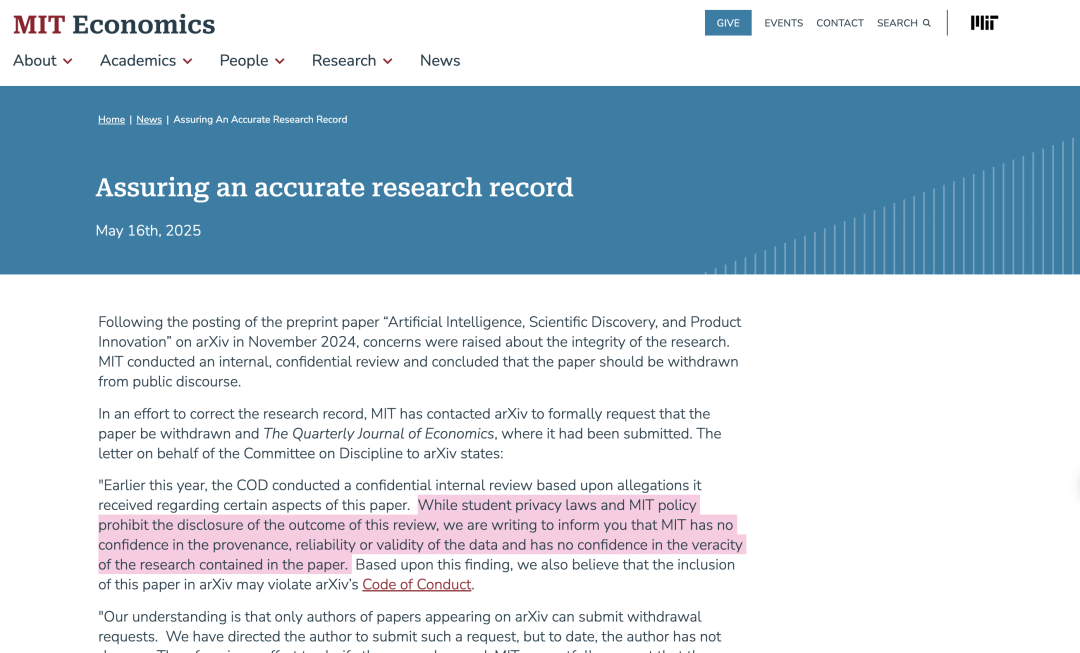
Even more serious is the possibility that AI might "beautify" its own results.Research has found that some AI systems selectively ignore data that does not match predictions, and may even generate false experimental records to conform to the model's conclusions.If this kind of "self-deception" is not detected in time, it may lead the entire research direction astray.
Talent Crisis: The Decline and Transformation of Traditional Scientific Research Capabilities
The rise of AI scientists is reshaping the demand structure for scientific research talent, and traditional "lone wolf" scientists are gradually losing their advantage."Dual talents" who are knowledgeable in their professional fields and proficient in AI technology are in high demand.In an interview, Harvard University professor George Church emphasized that biologists do not need to be proficient in AI algorithms, but they must understand the limitations of AI and be able to judge the rationality of AI results. This "professional + AI collaborative ability" will become the core competitiveness of researchers.
This transformation presents significant challenges to existing researchers.According to Wiley's 2025 Global Researchers Survey (sample size 2,430), 841,000 researchers (TP3T) are already using AI tools in their research.However, only 48% respondents believed that AI could help improve critical thinking, and more than half of them had concerns about the use of AI. The core concerns focused on two aspects: First, traditional skills are facing restructuring. 64% respondents worried that AI might generate errors or "illusions," and 58% were concerned about privacy and security issues. Senior researchers who are used to designing experiments and analyzing data by hand find it difficult to quickly adapt to the new working mode of "asking AI questions and interpreting AI results."
Furthermore, the lagging education system exacerbates the talent crisis. Currently, most STEM programs in universities worldwide still rely heavily on traditional courses, with a severe lack of integration of AI with research methodologies in teaching.Only a few universities offer practical courses such as "Application of AI Research Tools" and "Human-Machine Collaborative Experiment Design".This results in students possessing professional theoretical knowledge but lacking the ability to collaborate with AI. A Wiley survey shows that researchers at 57% believe that "lack of usage guidelines and training" is the main obstacle to the promotion of AI, and recent graduates often need additional training to adapt to the new workflow in the lab.
More alarmingly, over-reliance on AI may weaken fundamental abilities: MIT research indicates that AI may reduce brain activity, and when AI is widely used for data processing and formula derivation, students may neglect mathematical foundations and experimental skills training if they lack guidance, which are precisely the basis of scientific innovation.
Despite the numerous challenges, the deep integration of AI and scientific research is an irreversible trend. A Wiley survey shows that 831% of respondents believe AI will become an important part of scientific research by 2027, and 571% indicated they would be willing to allow AI agents to autonomously perform some research tasks if AI agents become sufficiently mature. This means that both researchers and the education system need to proactively adapt to change—researchers need to supplement their skills in applying AI tools and interpreting results, while universities need to accelerate curriculum reforms and integrate AI research methods into core teaching in order to cultivate "dual-skilled talents" who meet future needs.
Conclusion: A New Scientific Era Co-created by AI and Humanity
From Sakana AI's fully automated system to Professor Yaghi's "from molecule to society" cycle, AI scientists are irreversibly reshaping the landscape of scientific research. This revolution is not only in speed and scale, but also in thinking—when AI can explore scientific paths unimaginable to humans, and when interdisciplinary collaboration is no longer limited by the boundaries of human knowledge, the efficiency and breadth of scientific discovery are entering a period of explosive growth.
However, we must be soberly aware that AI scientists are ultimately an extension of human intelligence, not a replacement.It lacks the uniquely human intuition, value judgment, and innovative inspiration, and cannot capture scientific opportunities from accidental phenomena like humans can, nor can it understand the social significance behind research results.
The ultimate goal of science is to explore the unknown and improve humanity's destiny. The rise of AI scientists makes achieving this goal faster and more efficient. The words of Yaghi, the 2025 Nobel laureate in Chemistry, perhaps best illustrate this: "We are not accelerating experiments, but accelerating humanity's ability to solve problems."
Reference Links:
1.https://sakana.ai/ai-scientist/
2.http://m.toutiao.com/group/7559872054532407823/
3.https://www.businessinsider.com/openai-cofounder-andrej-karpathy-keep-ai-on-the-leash-2025-6
4.https://www.dwarkesh.com/p/andrej-karpathy
5.https://mp.weixin.qq.com/s/qUL3jhyZcIZI7cBQac1vbg